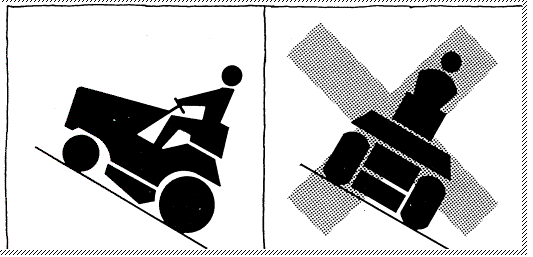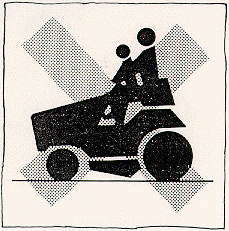Riding Lawnmowers
Consumer Product Safety Commission
Riding Lawnmowers
Document #588
While homeowners generally rely on walk-behind power lawnmowers to cut small plots of grass, many suburban and country residents with large lawns have automated their grass-cutting chores out of necessity. With lots of grass needing to be cut each week, rural homeowners have come to rely on riding mowers, lawn tractors, and garden tractors as indispensable machines for maintaining the landscape. Aside from cutting large swaths of grass, some machines also accommodate a host of attachments to make quick work of otherwise cumbersome garden projects.
Although many thousands of homeowners have driven these mowers and tractors for years without mishap, others haven't been as fortunate. Hazards most often associated with riding equipment are blade contact and loss of stability. The U.S. Consumer Product Safety Commission estimates that 18,000 consumer injuries related to riding mower mishaps were treated in hospital emergency rooms in 1986. Between 1983-1986, there were an estimated 75 deaths each year related to riding mower, lawn tractors and garden tractor accidents.
Fatal accidents have several common patterns: the machine tips over, the victim falls under or is run over by the machine (accidents involving young children fall in this category), or the victim is thrown from or falls off the machine. The risk of an accident with a ride-on mower is almost twice the chance of a mishap with a walk-behind rotary mower.
Many new riding mowers and tractors will have new safety features not found on older machines. Under new provisions of a voluntary safety standard which took effect for units made after July, 1987, the following features have been incorporated into new equipment:
- Operator Presence Control. This device will stop the rotary blades if the operator leaves the control position of the riding mower or tractor without first disengaging the blade drive. This safety feature will reduce the chance of injury if the operator leaves the control position to unclog the discharge chute or perform some other activity without first stopping the mower blade(s).
- Increased seatback height. New machines have seatbacks of at least 4 1/2 inches to help the operator maintain a safe position on the machine.
- Dynamic turn and sudden traction performance limits have been added to improve machine stability.
If you are shopping for a new machine, a label certifying that the mower or garden tractor meets the 1986 ANSI 871.1 standard indicates that machines have these safety features.
SAFE OPERATING PRACTICES FOR RIDE-ON MOWERS
I. General Operation.
This cutting machine is capable of amputating hands and feet and throwing objects that are hit by the blade. Failure to observe the following safety instructions could result in serious injury or death to the operator and/or bystander.

- Read, understand, and follow the safety and operating instructions that are in the manual and on the unit.
- Allow only responsible adults who are familiar with the instructions and with proper operating procedures to operate the machine.
- Clear the mowing area of objects such as rocks, toys, wire, etc., which could be picked up and thrown by the blade.
- Be sure the area is clear of other people before mowing. Stop the mower if anyone enters the area.
- Never carry passengers.
- Do not mow in reverse unless absolutely necessary. Bring the machine to a full stop before shifting to reverse. Always look behind before and while operating in reverse.
- Be aware of the discharge direction and do not point it at anyone.
- Slow down before turning.
- Never leave a running machine unattended. Always turn off the blades, set the parking brake, stop the engine, and remove the keys before dismounting.
- Turn off blades and attachments when not mowing.
- Stop the engine before removing the grass catcher or unclogging the chute.
- Mow only in daylight or good artificial light.
- Do not operate the machine while under the influence of alcohol or drugs.
- Watch for traffic when operating near or crossing roadways.
II. Slope Operation
Slopes are a major factor related to tipover and loss of control accidents, which can result in severe injury or death. All slopes require extra caution. If you cannot back up the slope or if you feel uneasy on it, do not mow it.
DO
- Mow up and down slopes, not across.
- Remove obstacles such as rocks, downed tree limbs, etc.
- Watch for holes, ruts or bumps. Uneven terrain could cause the mower to overturn. Tall grass can hide obstacles. Use slow speed. Shift into a lower gear before going on a slope. Choose a low enough gear so that you will not have to stop or shift while on the slope.
- Follow the manufacturer's recommendations for wheel weights or counterweights to improve stability.
- Use extra care with grass catchers or other attachments. These can change the stability of the mower.
- Empty grass catcher bags when they are only partially full.
- Keep all movement on slopes slow and gradual. Avoid sudden changes in speed and direction.
- Avoid starting or stopping on a slope. If tires lose traction, disengage the blades, and proceed slowly straight down the slope.
DO NOT
- Do not turn on slopes unless unavoidable; then, with the blades) disengaged, turn slowly and gradually downhill.
- Do not mow near dropoffs, ditches, or embankments. A wheel over the edge or an edge caving in could cause sudden overturn.
- Do not mow on wet grass. Reduced traction could cause sliding.
- Do not try to stabilize the machine by putting your foot on the ground.
- Do not use a grass catcher on steep slopes or rough terrains.
III. Children.
Tragic accidents can occur if the operator is not alert to the presence of children. Children are often attracted to the mower and the mowing activity. Never assume that children will remain where you last saw them.
- Keep small children out of the mowing area, preferably indoors under the watchful care of an adult other than the operator.
- Be alert and turn the mower off if children enter the area.
- Before and when operating in reverse, look behind and down for small children.
- Never carry children. They may fall off and be seriously injured or interfere with safe mower operation.
- Never allow children to operate the mower.
- Use extra care when approaching corners, shrubs, and trees.
IV. Service
- Use extra care in handling gasoline. It is flammable, and the vapors are explosive.
A. Use only an approved container.
B. Never remove the gas cap or add fuel with the engine running. Allow the engine to cool before refueling.
C. Never refuel the machine indoors.
D. Never store the machine or gasoline container inside the house where there is an open flame, such as a gas water heater.
E. Always clean up spilled gasoline.
- Never run a machine inside a closed area without good ventilation.
- Keep nuts and bolts, especially blade attachment bolts, tight and keep equipment in good condition.
- Never tamper with safety devices. Check their operation regularly.
- Keep the machine free of grass, leaves, and oil build-up to prevent fire.
- Stop and inspect the equipment if you strike an object. Repair if necessary before restarting.
- Never make adjustments or repairs with the engine running.
- Grass catcher components are subject to damage and deterioration. To reduce the thrown object hazard, periodically check and replace with manufacturer's recommended parts, when necessary.
- Mower blades are sharp and can cut. Wrap the blades or wear gloves and use extra caution when servicing them.
- Check brake operation frequently. Adjust and service as required.
008804


